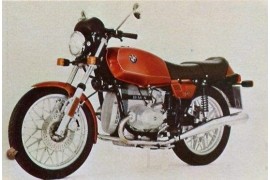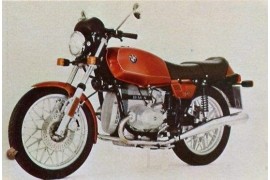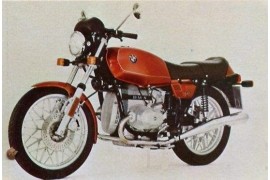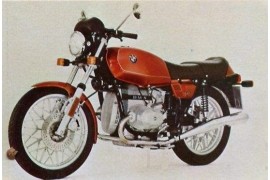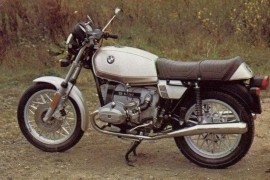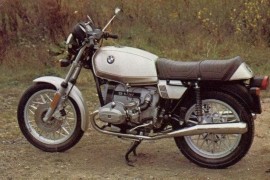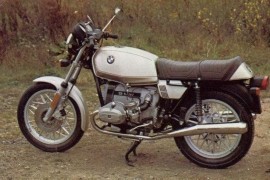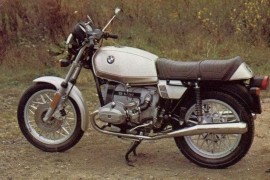BMW R 45 Models/Series Timeline, Specifications & Photos
First production year: 1977
In 1984, the German motorcycle maker released the BMW R 45, a light and agile motorcycle created by the House of Munich in 1978. The 1984 model came in the same shape and form as the previous one without significant changes.
The BMW R 45 was a mid-range motorcycle manufactured by BMW from 1978 to 1985. It was set in motion by a twin-cylinder boxer engine coupled to a five-speed transmission and a shaft final drive.
In 1979, the 27 hp version of the BMW R 45 was the best-selling motorcycle in Germany. By the time it was revised in 1980, the maker produced over 15,900 units. In addition, by the time it ended production, over 28,150 units were manufactured.
The bike's visual department was characterized by standard features, such as multi-spoke aluminum wheels, a center stand, a two-into-one exhaust system with a silencer mounted on each side, dual shocks on the rear, a one-piece dual seat, a round headlight, and a front fender mounted close to the wheel.
The motorcycle's front end was controlled by a telescopic fork and a single brake disc, while the rear end was handled by two side-mounted shock absorbers and a drum braking unit.
As for power, the 1984BMW R 45 had its heartbeat set by a 453cc four-stroke air-cooled twin-cylinder boxer engine fed by two Bing carburetors, delivering an output power of 27 hp at 6,500 rpm and 38 Nm (28 lb-ft) torque at 5,500 rpm.
The BMW R 45 was a mid-range motorcycle produced by BMW from 1978 to 1985. It was powered by a twin-cylinder boxer engine assisted by a five-speed transmission and a shaft final drive.
The bike was available in two engine configurations. The one with 27 hp was the best-selling motorcycle in Germany, and by the time it was revised in 1980, the maker produced over 15,900 units. In addition, by the time it ended production, over 28,150 units were manufactured.
In 1983, the German motorcycle maker released the BMW R 45, which debuted in 1978. It was in its sixth consecutive production year and packed the same specifications as the previous one without significant modifications.
In the aesthetic department, the motorcycle had standard features, such as multi-spoke aluminum wheels, a center stand, a two-into-one exhaust system with a silencer mounted on each side, dual shocks on the rear, a one-piece dual seat, a round headlight, and a front fender mounted close to the wheel.
As for the power figures, the 1983 BMW R 45 delivered an output power of 27 hp at 6,500 rpm and 38 Nm (28 lb-ft) torque at 5,500 rpm from a 453cc four-stroke air-cooled twin-cylinder boxer engine fed by two Bing carburetors.
The bike's front end was controlled by a telescopic fork and a single brake disc, while the rear end was handled by two side-mounted shock absorbers and a drum braking unit.
In 1982, the German motorcycle maker released the BMW R 45, a motorcycle in its fifth consecutive production year that packed the same technical, visual, and performance specifications as the previous one without significant modifications.
The bike debuted in 1978 and continued production until 1985. It was available in two versions, a less powerful one with 27 hp on tap and a more powerful version with 35 hp on tap with a claimed top speed of 160 kph (99 mph).
In 1979, the 27 hp model was the best-selling motorcycle in Germany, and by the time it was revised in 1980, the maker produced over 15,900 units. In addition, by the time it ended production, over 28,150 units were manufactured.
In the performance department, the 1982 BMW R 45 had its soul brought to life by a 453cc four-stroke air-cooled twin-cylinder boxer engine that delivered an output power of 27 hp at 6,500 rpm and 38 Nm (28 lb-ft) torque at 5,500 rpm.
The motorcycle's aesthetic department was characterized by standard features, such as a front fender mounted close to the wheel, a round headlight, a one-piece dual seat, side-mounted rear shocks, a two-into-two exhaust system with a silencer mounted on each side, a center stand, and multi-spoke aluminum wheels.
The bike was built around a steel frame with a telescopic fork on the front and a single brake disc, while the rear end was handled by two side-mounted shock absorbers and a drum braking unit.
The BMW R 45 was a mid-range motorcycle manufactured by BMW from 1978 to 1985. It was powered by a twin-cylinder boxer engine assisted by a five-speed transmission and a shaft final drive.
In 1981, the German motorcycle manufacturer released the BMW R 45, a motorcycle in its fourth consecutive production year. Compared to the previous model, the 1981 motorcycle was revised.
Some modifications included Nikasil-coated cylinders, making them more durable and lighter, a transistor ignition, a geared one plate to the clutch, making gear changes smoother, a larger oil pan, and better lubrication for the crankshaft.
Other modifications included a second interference pipe, the choke lever moved from the engine block to the left handlebar fitting, and a redesigned air filter with a plate filter and a black housing.
In the visual department, the motorcycle had standard fittings, such as a front fender mounted close to the wheel, a round headlight, a one-piece dual seat, side-mounted rear shocks, a two-into-two exhaust system with a silencer mounted on each side, a center stand, and multi-spoke aluminum wheels.
The 1981 BMW R 45 was powered by a 453cc four-stroke twin-cylinder air-cooled boxer engine mounted underneath the fuel tank, delivering an output power of 27 hp at 6,500 rpm and 38 Nm (28 lb-ft) torque at 5,500 rpm.
The BMW R 45 was a mid-range motorcycle made by BMW from 1978 to 1985, wearing a twin-cylinder boxer engine tied to a five-speed transmission and a shaft final drive.
The bike was available in two engine configurations. The one with 27 hp on tap was the best-selling motorcycle in Germany, and by the time it was revised in 1980, the maker produced over 15,900 units. In addition, by the time it ended production, over 28,150 units were manufactured.
In 1980, the German motorcycle manufacturer released the BMW R 45, a motorcycle in its third consecutive production year that featured the same technical, visual, and performance specifications as the previous model without any modifications.
The bike's visual department was characterized by standard features, such as a front fender mounted close to the wheel, a round headlight, a one-piece dual seat, side-mounted rear shocks, a two-into-two exhaust system with a silencer mounted on each side, a center stand, and multi-spoke aluminum wheels.
In the performance department, the 1980 BMW R 45 had its soul brought to life by a 453cc four-stroke air-cooled twin-cylinder boxer engine underneath its fuel tank, delivering an output power of 27 hp with a peak force at 6,500 rpm and 38 Nm (28 lb-ft) torque at 5,500 rpm.
As for the braking power, the motorcycle packed two 260 mm brake discs with two-piston calipers on the front wheel and a 200 mm drum braking unit on the rear wheel.
In 1979, the German motorcycle manufacturer released the BMW R 45, a mid-range motorcycle created by BMW in 1978 and manufactured until 1985. It was powered by a 473cc air-cooled twin-cylinder boxer engine tied to a five-speed transmission and a shaft drive.
The 27 hp 1979 model was the best-selling motorcycle in Germany, and by the time it was revised in 1980, the maker produced over 15,900 units. In addition, by the time it ended production, over 28,150 units were manufactured.
Visually, the bike was complemented by standard features, such as a front fender mounted close to the wheel, a round headlight, a one-piece dual seat, side-mounted rear shocks, a two-into-two exhaust system with a silencer mounted on each side, a center stand, and multi-spoke aluminum wheels.
For suspension, the motorcycle packed a hydraulic telescopic fork on the front with 175 mm of travel and a long swingarm with side-mounted shock absorbers on the rear that provided 110 mm of travel.
As for the braking power, the motorcycle packed two 260 mm brake rotors on the front coupled to dual-piston calipers and a single 200 mm drum braking unit on the rear, offering optimum stopping performance.
In the performance department, the 1979 BMW R 45 had its soul brought to life by a 453cc four-stroke two-cylinder air-cooled engine that delivered an output power of 27 hp at 6,500 rpm and 38 Nm (28 lb-ft) torque at 5,500 rpm.
In 1978, at the International Bicycle and Motorcycle Show (IFMA), BMW surprised the public with an entirely new small series of motorcycles. The highlighted models, the BMW R 45 and R 65, were created to fill the gap left by the discontinued entry-level models R 50/5 and R 60/7.
The newly released models were new developments, even though BMW retained the principle of the two-cylinder engine mounted transversal on the frame coupled to a cardan shaft drive. The engine and the double loop frame were new designs.
Compared with the larger boxer, the 1978 BMW R 45's engine was narrower, and the frame was much smaller and lighter.
The model was available in two versions with an engine displacement of 473cc but a different power output of 27 and 35 hp. Due to the new insurance classes that were going on at the time, the 35 hp version had no use in the German market and had demands almost entirely from abroad.
The 473cc R 45 model, powered by a twin-cylinder boxer engine with a power output of 27 hp at 6,500 rpm and 38 Nm (28 lb-ft) of torque at 5,200 rpm, benefitted from the insurance class and became the best-selling motorcycle in the BMW range. In 1979, it was the biggest-selling motorcycle in Germany.
The R 45 came with standard features such as laced wheels, a chromed dual exhaust system, a small round headlight, an analog instrumentation panel, a dual seat, a blacked-out frame, and a center stand.
In 1985, the German motorcycle manufacturer released the BMW R 45, a motorcycle in its eighth and final year of production. The bike was manufactured for eight years, from 1978 to 1985. Until it was revised in 1980, the maker produced over 15,900 units, and by the time it ended production in 1985, more than 28,150 units were produced.
The BMW R 45 was a mid-range motorcycle produced by BMW from 1978 to 1985. It was powered by a twin-cylinder boxer engine assisted by a five-speed transmission and a shaft final drive.
The bike was available in two versions, one with 27 hp and the other with 35 hp, with a claimed top speed of 160 kph (99 mph). In 1979, the 27-hp model was the best-selling motorcycle in Germany.
The 1985 model came in the same shape and form as the previous one, delivering the same technical, visual, and performance specifications without any significant modifications whatsoever.
In the aesthetic department, the motorcycle packed standard fittings, such as a front fender mounted close to the wheel, a round headlight, a one-piece dual seat, side-mounted rear shocks, a two-into-two exhaust system with a silencer mounted on each side, a center stand, and multi-spoke aluminum wheels.
As for the power figures, the 1985 BMW R 45 had its soul brought to life by a 453cc four-stroke air-cooled twin-cylinder boxer engine with two Bing carburetors in charge, boasting 27 hp at 6,500 rpm and 38 Nm (28 lb-ft) torque at 5,500 rpm.
